
As a result of regular screening with the Papanicolaou (Pap) test, deaths from cervical cancer among American women have decreased by more than 70% during the last 50 years.

As a result of regular screening with the Papanicolaou (Pap) test, deaths from cervical cancer among American women have decreased by more than 70% during the last 50 years.

A 47-year-old woman who wasseropositive for HIV-1 presented tothe emergency department with severemaculopapular, erythematouseruptions. Her antiviral regimen hadrecently been changed from zidovudine, 300 mg bid; lamivudine, 150 mgbid; and saquinavir, 600 mg tid, tolamivudine, 150 mg bid; stavudine, 40mg bid; and nevirapine, 200 mg/d.

What are the appropriate laboratory tests for an infant whose mother has hepatitisC virus (HCV) infection?

A 32-year-old previously healthywoman presents to the emergencydepartment with skin lesions, suprapubicpain, and generalized myalgia of1 week’s duration. Trimethoprim-sulfamethoxazolefor a presumed urinarytract infection is prescribed, and thepatient is discharged. The symptomspersist; she is hospitalized 2 days later.

ABSTRACT: Many patients with osteoarthritis (OA) try such complementary therapies as special diets, nutritional and herbal supplements, yoga, t'ai chi, magnets, and acupuncture-but only 40% of these patients tell their physicians. Glucosamine and chondroitin sulfate can produce at least symptomatic relief; in addition, glucosamine (1500 mg/d) may increase or stabilize cartilage in osteoarthritic knees. Alert patients to the potential toxicities of many herbal remedies, as well as the risks of harmful drug interactions and possible contaminants and impurities. Yoga postures may have a beneficial effect on knee OA; t'ai chi may reduce joint pain and swelling and increase mobility. Small studies have shown that applied pulsed electromagnetic fields can reduce pain and improve function in patients with chronic knee OA. Acupuncture has also been shown, in small studies, to alleviate the pain of OA. Autologous chondrocyte transplantation was recently approved for treatment of knee OA. The efficacy and safety of various types of gene therapy are currently being evaluated.

Q:Should I prescribe isoniazid prophylaxis for an elderly patient withmultiple health problems who recently converted from negative topositive tuberculin status?

Primary care providers are seeingan increasing number ofpatients who have snakes orbarbwire coiling around theirarms or gold rings danglingfrom their eyebrows and navels. Tattooingand body piercing are particularlypopular among adolescents andyoung adults-many of whom may notbe aware of the possible medical complicationsof these ancient practices.

The most common blood-borne infection in the United States, hepatitis C is also one of the leading causes of chronic liver disease in this country. About 35,000 new hepatitis C virus (HCV) infections are diagnosed each year; by 2015, the number of persons with documented HCV infection is expected to have increased 4-fold from what it was in 1990.

ABSTRACT: Patients can greatly reduce the risk of traveler's diarrhea by drinking only bottled water and eating only hot foods prepared in sanitary conditions or peelable fruits and vegetables. Antibiotic prophylaxis for traveler's diarrhea is no longer routinely recommended; reserve it for patients who may have to consume food and beverages of questionable safety, those with reduced immunity, and those likely to experience serious consequences of illness. Adequate hydration is the first step in treating traveler's diarrhea. Drug therapy-loperamide or fluoroquinolones in adults and bismuth subsalicylate or azithromycin in children-can ameliorate symptoms and speed recovery. Recommend that patients who are prone to motion sickness take an antiemetic/antivertigo agent before symptoms begin. Acetazolamide can be used both to prevent and to treat altitude sickness. Contraindications to air travel include a resting oxygen saturation of less than 90%, pregnancy of more than 36 weeks' duration, pneumothorax, recent myocardial infarction or chest or abdominal surgery, active infectious diseases, and poorly controlled seizures or sickle cell anemia.

A 78-year-old man presented to theemergency department with a 3-weekhistory of progressive shortness of breathand cough with blood-streaked, yellowishsputum. The patient had dyspnea onexertion limited to 2 blocks, 2-pilloworthopnea, paroxysmal nocturnal dyspnea,and nocturia. Neither fever norchills were present. He had lost 7.2 kg(16 lb) during the last year.
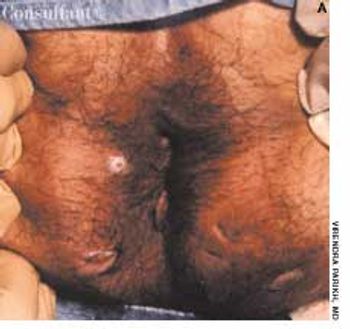
Fourteen months of intermittent, foul-smelling, perianal discharge prompted a 45-year-old man to seek medical evaluation. He also complained of occasional bright red rectal bleeding and soreness of the perianal region; he denied fever.
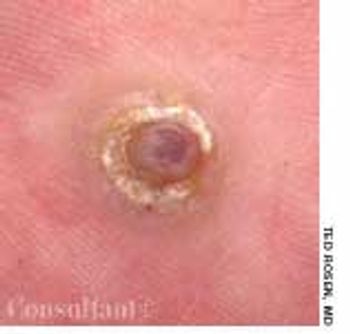
A 32-year-old man who was seropositive for HIV presented with a tender lesion on his right foot of about 3 months' duration. The patient's only medication was zidovudine. His CD4+ cell count was 120/µL.

Even though highly active antiretroviral therapies and effective chemoprophylaxis are available, the exposure of HIV-infected patients to opportunistic pathogens remains a concern.

Foot ulcerations and infections are the leading cause of hospitalizationamong patients with diabetes; they occur in about15% of these patients. Given the rapidly increasing incidenceof diabetes, physicians can expect to see a growing numberof diabetic foot problems. Here, a group of experts, many ofwhom practice at the renowned Joslin-Beth Israel DeaconessFoot Center in Boston, offer guidance on all aspects of diabeticfoot care. The topics covered range from proven preventivestrategies to cutting-edge wound care techniques that drawon such new developments as growth factors and living skinequivalents. A detailed review of the pathophysiology of thediabetic foot is also included. The emphasis throughout is ona multidisciplinary approach that incorporates the servicesof diabetologists, podiatrists, orthopedic surgeons, orthotists,diabetic nurse educators, and others. Numerous black-and-whiteand color photographs, drawings, algorithms, and charts illustratethe text.

A 72-year-old man slipped and fell backward in the bathroom, hitting hishead on the toilet seat; he suffered only minimal discomfort. The followingday, he presented with mild back pain and extensive bruising.

Which treatment approaches are effective in a woman who has persistent or refractory vaginal trichomoniasis? Should the male sex partner of a patient who has recurrent vulvovaginal candidiasis be treated? Answers to these and other questions can be found in the recently updated CDC guidelines on managing sexually transmitted diseases

ABSTRACT: When a solitary lung nodule is detected, the key question is whether the lesion is malignant. The initial evaluation includes a careful history taking focused on risk factors for malignancy, a thorough physical examination, comparison of current chest films with previous ones, and CT scanning. Radiologic signs that suggest malignancy include lesion size greater than 2 cm in diameter, spiculated margins, lack of calcification, and change in size. Video-assisted thoracoscopic surgery or thoracotomy is the next step for patients with a suspected malignant lesion. If the results of the initial evaluation are equivocal, positron emission tomography (PET) scanning is the preferred follow-up.
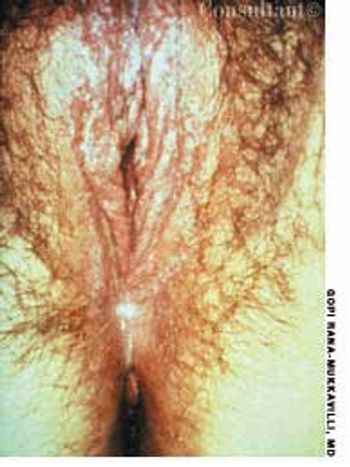
For 3 days, a 23-yearold woman had been bothered by pruritic vaginal and vulvar lesions. A cheesy white vaginal discharge was associated with the itching. She denied being sexually active.
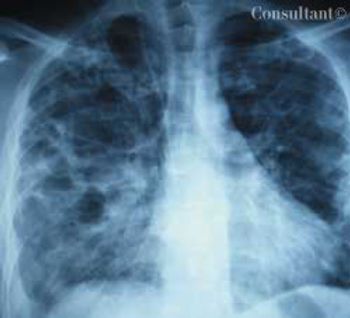
A 33-year-old man with AIDS presented to the emergency department with fever, dyspnea, cough, and pleuritic chest pain of 3 days’ duration. He had had a Pneumocystis carinii infection 3 years before recently emigrating from the Dominican Republic to the United States.

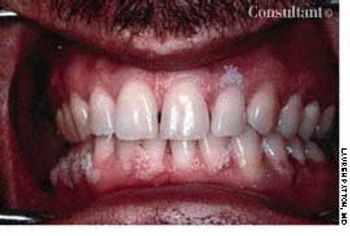
Seen here are asymptomatic papillary growths on the gingiva of a 31-year-old homosexual man who is seropositive for HIV. The diagnosis of human papillomavirus (HPV) lesions can be based on appearance and history. Condylomas may also appear flat and smooth or nodular, resembling fibromas. Because cross infection is common, patients who have these lesions-and their partners-are at increased risk for contracting anal and genital condylomas.

A 25-year-old man presented with an erythematous, pruritic, scaly, macular rash that had begun behind his ears and spread over his neck, chest, trunk, and upper and lower extremities.